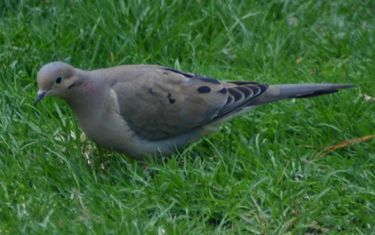Mourning dove - Zenaida macroura
General: The Mourning Dove (Zenaida macroura) is a member of the dove family, Columbidae. The bird is also called the American Mourning Dove, and formerly was known as the Carolina Pigeon or Carolina  Turtledove. It ranges from Central America to southern Canada, including offshore islands. Many individuals in northern areas migrate south to winter within the breeding range where January temperatures are greater than minus 12 Celsius (10 F). Turtledove. It ranges from Central America to southern Canada, including offshore islands. Many individuals in northern areas migrate south to winter within the breeding range where January temperatures are greater than minus 12 Celsius (10 F).
Mourning doves live in various open and semi-open environments, including agricultural and urban areas. The species has adapted well to areas altered by humans. The bird is abundant, with an estimated population of 130 million birds. In many areas, the Mourning Dove is hunted as a game bird for both sport and its flesh. Its plaintive woo-oo-oo-oo call is common throughout its range, as is the whistling of its wings as it takes flight. The species is a strong flier, capable of speeds up to 88 km/h (55 mph).
Mourning Doves eat almost exclusively seeds, which make up more than 99% of their diet. Rarely, they will  eat snails or insects. Mourning Doves generally eat enough to fill their crops and then fly away to digest while resting. They often swallow grit such as fine gravel or sand to assist with digestion. The species usually forages on the ground, including at bird feeders. eat snails or insects. Mourning Doves generally eat enough to fill their crops and then fly away to digest while resting. They often swallow grit such as fine gravel or sand to assist with digestion. The species usually forages on the ground, including at bird feeders.
Identification Tips: Mourning doves are approximately 10.5 inches long. The sexes are similar. They are a medium-sized, somewhat slender dove with very thin neck. Mourning doves have black bills.
Identification of adult mourning doves is: Pale buff-brown head, neck, breast, and belly, purple and green iridescence on neck, small black mark on lower neck, medium brown back and upperwings, with large black spots on coverts. Their long tail is pointed at the tip. They have dark brown tail with white tips to outer four tail feathers.
Coloration Juvenile: Dark brown mottled head neck and breast, scaly neck and upperwings with numerous black spots on coverts and scapulars. They have pale belly. Their medium length tail is pointed at the tip.
From Wikipedia, the free encyclopedia
|


 Turtledove. It ranges from Central America to southern Canada, including offshore islands. Many individuals in northern areas migrate south to winter within the breeding range where January temperatures are greater than minus 12 Celsius (10 F).
Turtledove. It ranges from Central America to southern Canada, including offshore islands. Many individuals in northern areas migrate south to winter within the breeding range where January temperatures are greater than minus 12 Celsius (10 F). eat snails or insects. Mourning Doves generally eat enough to fill their crops and then fly away to digest while resting. They often swallow grit such as fine gravel or sand to assist with digestion. The species usually forages on the ground, including at bird feeders.
eat snails or insects. Mourning Doves generally eat enough to fill their crops and then fly away to digest while resting. They often swallow grit such as fine gravel or sand to assist with digestion. The species usually forages on the ground, including at bird feeders.